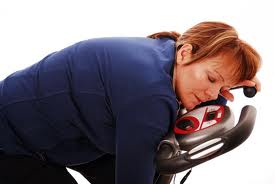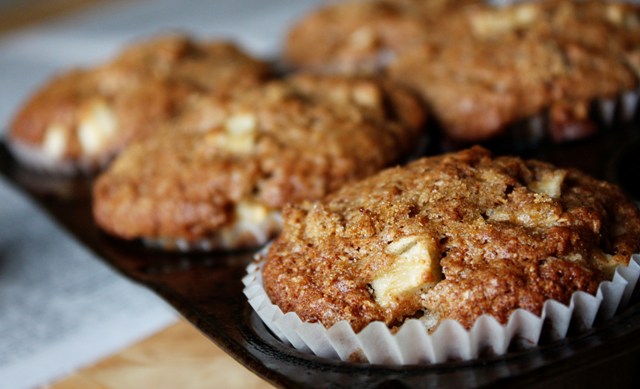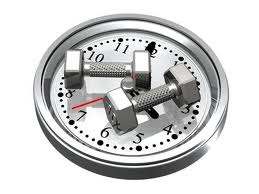While the holidays seem to be the busiest time of the year it is sooo important to make time to still get in your workouts!
Fit in mini moments of activity through out the day if you are super busy!! Whatever it is, make it count!!
10 minutes? PERFECT! That is just enough time to elevate your heart rate and get in a good sweat!!
Mini workout to try:
~50 lunges (alternating legs)
~50 squats
~as many push ups you can get in 1 minutes
~jump tucks-- as many as you can get in 1 minute
~triceps dips on the ground (as many you can get in 1 minute)
It's not just what you eat but when you eat that matters. The perfect food for one situation may be horrible for another. Nutrient timing is a science that athletes use to try to get the most out of every calorie they consume. Not everyone needs an athlete's level of efficiency, but all of us will benefit from a basic understanding of nutrient timing.
This is 911, need-to-know info only. To keep you focused on the big picture, I'll begin with an example at the extreme end of nutrient timing. If the average Joe followed the same diet as an Ironman triathlete, he'd likely have type 2 diabetes in a matter of months. Conversely, if someone tried to complete an Ironman on even the healthiest version of a low-carb diet, that person would either be forced to quit or die. This is not just because either diet would mean eating too much food or too little food. Different foods cause the body's metabolic process to react in different ways; and various activities should be fueled using various means.
Let's begin by looking at our possible fuel sources:
Carbohydrates
Are fuel only. They aren't stored in body tissue, only in the blood and liver as glycogen, which needs to be burnt off. They are essential for high-level functioning like running fast, lifting heavy things, and thinking. They are digested and put to use by your body very quickly. If you eat more than you burn, your body will convert them to be stored in adipose (fat) tissue.
Proteins
Called the body's building blocks. Hence, you need them to rebuild tissue that breaks down daily. You digest proteins slowly, and at a certain point, your body just can't assimilate them. Therefore, it's important that throughout the day you eat foods that are high in protein.
Fats
Help regulate all of your bodily functions. They are dense and contain over twice the calories of proteins and carbohydrates. While they are vital for our health, it's easy to eat too much of them, which will result in unwanted fat tissue on your body. You digest fats slowly, and fats will also help slow the digestion of anything else you eat. Fats are also your backup fuel source, though they can't be put to use right away the way carbs can.
Fiber
Categorized as a carbohydrate, it is not a source of fuel as it has no calories. It's the indigestible part of a plant and is of vital importance in your diet because it regulates the absorption of the foods you eat. It also helps us feel full. Most of us don't eat enough fiber, and that's a big part of the obesity problem.
Alcohol
Not really a food source but something we tend to consume. It has nearly twice the calories of proteins and carbs (though it lacks fuel) and digests rapidly. Its only healthy function is that it seems to make us happy. Studies indicate this is a good thing, as those who consume alcohol generally live longer than those who don't, but from a purely nutritional standpoint, it's not so hot because you're getting calories without any upside. Its use should be strategic and regulated for best results.
Now let's look at the various situations we face daily, at least on most days—hopefully.
Relaxing
This is when we're sedentary both physically and mentally. In a relaxed state, you burn very few calories because your body is engaged as little as possible, hence the relaxing.
Sedentary work
When we're at work or school. Our bodies aren't moving, but our brains are engaged. The brain runs on glycogen, which is blood sugar fueled by carbohydrates.
Low-level exercise
Like mowing the lawn, cleaning the house, or going for a walk. This breaks down body tissue, so you're burning calories, but it's not intense work. Therefore, it can be fueled by your stored body fat. Your body tries to fuel its low-level outputs by mobilizing fat stores because this saves its limited glycogen for emergency situations.
High-level exercise
Fueled by glycogen. When you really have to get after it, all sorts of hormones go to work, and your body burns its blood sugar. Body-tissue breakdown is rapid, and your stored blood sugar (glycogen) won't last much more than an hour.
Sleep
A very active time. Deep sleep is where your body works the hardest to repair itself. You need nutrients to make these repairs, but it's better if you aren't mucking up the process with digestion. This is why you hear that you shouldn't eat too much at night. It's best to eat early to allow most of the digestion to happen while you're awake, thus allowing your body to use all its energy for recovery during sleep. It is worth noting here that it's better to eat before bed if you need the nutrients—don't skip them. Your body can't repair itself without nutrients, and recovery from breakdown is why we eat in the first place. Next, let's take a look at an important word you need to know: insulin.
Insulin
Wikipedia tells us that insulin "is a hormone that has extensive effects on metabolism and other body functions, such as vascular compliance. Insulin causes cells in the liver, muscle, and fat tissue to take up glucose from the blood, storing it as glycogen in the liver and muscle, and stopping use of fat as an energy source." Okay, that's a little scientific, but look at all the things we've already referenced: hormone, glycogen, metabolism, and fat as an energy source. Even if you don't fully comprehend "vascular compliance," you can tell that insulin is something important in today's discussion.
Sure enough, it's the only hundred-dollar word we need to know today. Your body's insulin response is the main reason you want to eat certain foods at certain times, to do certain things.
Putting it all together
Now let's take what we've just learned and put it to use. For most of us, nutrient timing is pretty simple. The next thing to consider is what you're going to be doing or what you just did. As I said before, what you eat should be based on this. You've probably heard about the evils of sugar, or maybe even the glycemic index. Using the science of nutrient timing, you can turn sugar into something healthy because it's the only thing that transports nutrients into your blood quickly enough to be of service during and after hard exercise.
Essentially, sugar or other easily digested carbs (the less fiber the better) promote an insulin release. This speeds the transformation of carbohydrates into glucose in your blood. As your glycogen stores are depleted during exercise, recharging them with sugar minimizes the damage done by the breakdown of tissue during exercise. Therefore, sugar, the oft-vilified ingredient, is actually your body's preferred nutrient during times of excessive stress and tissue breakdown.
Pretty cool, huh? The bad news is that this miracle nutrient is not good for you when you're not doing intense exercise, which for almost all of us is most of the time. In fact, sugar's very bad for you because the insulin response that was so fabulous for you when you were bonking (glycogen depleted) is not so fabulous for you when you're sitting in front of the boob tube.
Remember this from the Wikipedia definition of insulin, "stopping use of fat as an energy source"? That's bad when you're sitting around. Remember how one of dietary fat's responsibilities is to fuel you during low-intensity exercise? Well, when sugar causes your insulin to spike, it cuts off that process. Now not only are you not burning body fat for low-level outputs, you're trying to force your body to use its glycogen. Double bad.
Unless you're exercising, sugar intake should be minimized. During these times—which is most of the time—your diet should consist of a mixture of proteins, fats, and complex carbohydrates. The latter are natural sources of carbohydrates that generally come with fiber, which regulates the insulin response. Whole fruit, a simple carbohydrate by definition because it contains fructose (a sugar), always contains fiber and, thus, can be treated as a complex carb. Fruit juice, and other such stuff, is processed; it, along with processed complex carbohydrates like white rice, can cause an insulin response, so these types of foods should be used more like sports foods than staples.
It's also important to note that combining all these different nutrients slows sugar's ability to incite insulin into action. Therefore, a little sugar like a dessert after a well-rounded meal is buffered by the meal. The calories and lack of decent nutrients (processed sugar is devoid of most nutrients, except for energy) still count toward your overall diet, but at least you don't have to worry about an insulin spike.
So the main point of this article is very simple. You should eat small, well-rounded meals most of the time. These should include some proteins, some fats, some fiber, and some carbs. During (only if it's a long workout) and after hard workouts, you should supplement your diet with sugar or simple carbohydrates. After this, you should go back to eating well-rounded meals again.
Sports nutrition has evolved this process even further. In nature, foods are generally slow to digest. Nature's great sports foods are things such as bananas and figs. These are sugary but still contain fiber and other nutrients. Science has found ways to make foods that are even more efficient during sports. These basically manipulate pH levels and process the sugars to speed them into your system. Outstanding when you need it. Terrible when you don't.
They've even taken this a step further by finding a ratio of other nonsugary nutrients (like protein) that can be transported by the sugar to give you a further benefit. Beachbody's Results and Recovery Formula uses this science. When you're bonking during a hard workout, it speeds nutrients that are essential for quick recovery into your system as quickly as possible.
I can't stress how important it is that sports fuels be used for sports performance only. Gatorade, soda, and all sugar candies (hey, no fat!) all function as the poor man's sports foods. Unfortunately, those perusing the Quick Stop generally aren't trying to fuel up after doing Plyo X, and therein may lay our obesity trend.
In case the topic is still a bit fuzzy, let's use the above logic on the examples in the intro: An Ironman athlete is doing intense exercise for 10 to 12 hours or more. During this time, that athlete is mainly burning glycogen, which is gone after an hour or so. The athlete burns stored fat, too, but this is limited in its effectiveness. To race, the athlete must replenish with sports foods because they contain the only nutrients that the athlete will digest fast enough to help. To complete an Ironman, especially at your physical limit, it may take 5,000 calories coming mainly from sugar.
This is a sports-specific diet only. Someone trying to eat that way during a viewing of the Lord of the Rings trilogy would be lucky to stay out of the emergency room. Conversely, if you tried to maintain a 25-mph speed for 8 hours on your bike while munching on raw spinach and lean steak, you'd bonk so hard you'd be praying to get yanked from the race at the first checkpoint. That should cover your 911 on nutrient timing. Next time, we'll move on to the topic of supplements. Are they magic pills, overhyped placebos, or something in between?
So here is a confession…I LOVE cardio! The feeling oh “AH” afterwards with all the sweat…amazing! I love that feeling, but of course not everyone feels that way. Obviously the calorie burning and heart health are super important but so is actually enjoying it. I think for some the monotony of treadmills, elliptical, stationary/spin bikes get boring quickly (I fit in this category). So here are some solutions for you: ~Take a class ~Do it with a friend…even just a couple of days a week some cardio can really improve your cardiovascular system ~Get outside and connect with nature! I don’t know about you guys but for me this is when I get in the zone! ~Find some great tunes! Another thing to get you pumped, distracted, and in no time burning a ton of calories! For the person trying to build muscle: ~Try adding some circuit training into the mix to elevate your heart rate while still avoiding the “traditional” To mix it up: ~Try HIIT training ( http://fitandhealthywithbeth.weebly.com/1/post/2011/10/interval-trianing-aka-hitt.html ) ~Try an at home workout like Insanity, TurboFire, or Combat Cardio is a good option to do 1-5 days a week…even if you do it in a non-traditional way the key is to focus on those heart benefits and get it in!!
The holidays are a crazy time of year between gifts, parties, family members, cooking and of course the holiday weight gain woes too. That certainly adds a lot to a person’s stress levels!!
Here are some easy tips for you to keep it cool this year!
o Make sure you still workout…even just 15 minutes will make you feel better
o Plan your meals…don’t leave any room for stress with what you will eat! Know what it will be and when/where it will come from.
o Accept that things will not be picture perfect…yes your family will probably mess something up but this is the time of year to just enjoy family!! SO LAUGH!
o Take a relaxing bath to unwind
o Make a play list that will help relieve tension
o Read a book!
o Plan ahead
o Scream…yes go ahead!
o Make to do lists
o Laugh!
o Enjoy some wine
o Write it out
The bottom line is whether it is money, family, fitness this time of year is crazy! So just embrace it and take it head on J
My Fit Christmas list…
So obviously there are so many more important things this time of year than gifts but I figured I would share my Fit Christmas List with you!
Well I have been a good girl all year so I hope that Santa remembers that when he thinks about what I get for Christmas!
Things I want…
· New cross trainers-Nike Free series in yellow!
· A fit bit for tracking my activities, foods, and workouts!
· A bigger lunch box…I pack every day to keep my foods on track and I am out of space in my current satchel!
· A bigger crock pot!! My favorite thing about winter is the cold weather foods like soups, stews, and roasts! We have a teeny tiny crock pot now but a larger one would certainly make things easier!!
What’s on your list?
Importance of sleep
Sleep and rest are so so so under rated in a good training regimen! Without these key features you are very unlikely to progress and move forward and here is why!
Just like a computer your body needs to shut down and reboot to process your day mentally but also to heal after the beating your workouts put on the body. Micro tears form in the muscle tissues and therefore need to heal so you can get stronger! No rest = no healing = no strength gain = higher risk of injury.
To clean out the toxins! You put foods in your body each day and whether they are healthy or not your body must clean out toxins from unhealthy foods as well as the chemicals, free radicals, and other harmful elements we come into contact with each day!
New recipe I am obsessed with comes from www.littlebshealthyhabits.com
zomgosh soooo good!!
Ingredients
2 cups rolled oats
1 medium apple, chopped into small cubes, skin on
2 scoops whey protein powder
4 egg whites 1 cup non fat Greek yogurt
6 packets of Truvia (you may want to add more if you like your baked goods sweet)
2 tsp cinnamon
1/2 tsp baking powder
pinch of salt
Directions 1. Pre heat oven to 350 degrees. Prepare muffin tin.
2.. Place all ingredients in Kitchen Aid mixer and mix well.
3. Divide batter into 12 muffin tins and bake at 350 for 16-18 minutes.
Not only do these taste awesome, but they make your house smell amazing too!
Nutrition: 1 muffin Calories: 95 Carbs:12g Fat: 1g Protein: 9g Sugar: 3g

We are visual creatures; we grab and eat anything that looks as though it is bursting with flavor! (Another big reason the fast food chains and restaurants show pictures!) The same goes for your own home with the pantry and fridge.
Chances are you either live with someone or have children that you allow to have treats in the house and they don’t necessarily match up with your goals. So what do you do? Obviously your family or roommates will be pretty upset with you for just tossing their junk food so your best bet is to change the lay out!
Instead of…
Having the junk food staring you in the face every time you open the door, place healthy foods at eye level. Example: those pretzels, chips, and cookies on the top shelf or very bottom shelf where your eyes are less likely to go to. In their place, place protein bars, oats, rice, foods that are healthy but may require some work! (many times cravings are something you just want right here right now and do not want to cook).
In the freezer hide the ice cream/unhealthy frozen treats behind frozen veggies and meats
In the fridge place unhealthy treats on bottom shelf and fruits/grab and go healthy snacks on top!

Sleep and rest are so so so under rated in a good training regimen! Without these key features you are very unlikely to progress and move forward and here is why!
Just like a computer your body needs to shut down and reboot to process your day mentally but also to heal after the beating your workouts put on the body. Micro tears form in the muscle tissues and therefore need to heal so you can get stronger! No rest = no healing = no strength gain = higher risk of injury.
To clean out the toxins! You put foods in your body each day and whether they are healthy or not your body must clean out toxins from unhealthy foods as well as the chemicals, free radicals, and other harmful elements we come into contact with each day!
While this time of year is the easiest time of year to throw in the towel, now is the most important time for you to keep yourself on track and getting at least 20 minutes a day!
As I have said before this time of year is very well known for weight gain and the eating holidays, but not for you!! Even if you don’t lose weight if you can get through these days without gaining that is still a huge accomplishment!
Even if you are busy here are some ideas for non-traditional calorie killers!
If you are shopping…
· Carry the basket and do not push the cart
· Park far from the entrance
· Eat before you go
· In line…(yes people may look at you funny but worth the booty of your dreams!) squat and lunge while waiting
Getting ready/cooking…
· Lunge while going from various places around your house
· Squeeze in a HIIT (High intensity interval training workout) while the food cooks
· Squat while you brush your teeth/shower
· Plank every time you do _____ activity.
· Make a game out of it!
Etc…
· Stand and wrap gifts
· Lunge while you vacuum/clean
· Drink your shakeology in place of one meal to curb cravings
· Water, water, water!
· Get in your veggies
I lol'd at this and it just seemed so fitting!
Unsurprisingly with all the treats and fattening foods this time of the year is notorious for weight gain! How much you may wonder? 7-12 pounds!! Yikes that is as much as a new born child! Now maybe your goal is more maintaining your current weight or maybe it is losing more either way you can still enjoy the holidays and stay focused on these! The key is moderation and knowing the difference between hungry, cravings, emotions, and peer pressure! Refer to http://fitandhealthywithbeth.weebly.com/1/post/2012/11/cravingshow-do-i-handle-them.html for help with cravings! As far as the holidays go, you best bet is to have a plan of attack, the holiday parties and events will happen and you will have 2 choices, to indulge or not! Here is your game plan: · Decide what holiday foods are non-negotiable then allow yourself to enjoy just a little! If your gam- gams makes your favorite pie then by all means have a slice, just not the whole pie!! · Plan ahead- we all know the types of foods and goodies to expect at family and holiday parties right? Okay so plan your plate, ½ proteins, ¼ veggies, and ¼ carbs and sweets (see just a little not the whole table!!). Why? You can fuel up on healthier options and still enjoy just a touch of your favorites. · If there will be absolutely zero healthy options then either bring some or eat before hand! · Pack emergency foods- we all get stuck somewhere and rather than starving or giving into junk foods carry some minor foods to hold you over! (EX: almonds/nuts, apples, protein bars) · Get your sweat on that day…not only do you burn off calories but you keep cravings subsided. · Sit or stand away from foods tables · Go easy on booze and sugary drinks · Wait a while between different plates…allow yourself to process the food and then go back in for more if you are still hungry. · Eat slowly!! Your brain takes about 20 minutes to realize you are full and you could easily over eat otherwise! · Don’t beat yourself up over what you ate..move on! · Track it…if you are conscientious of what you eat, you are likely to stay on track more easily! · Wear clothes that are a little snug…if you are aware of your body and what you are putting into you will be also less likely to over eat! · And lastly…just throw the junk food in your house away! So what is your plan of attack?
|








 RSS Feed
RSS Feed